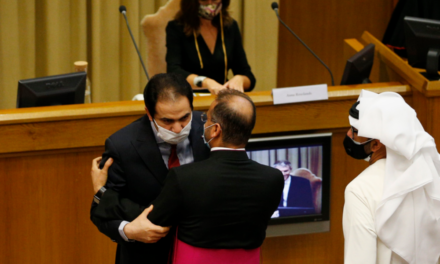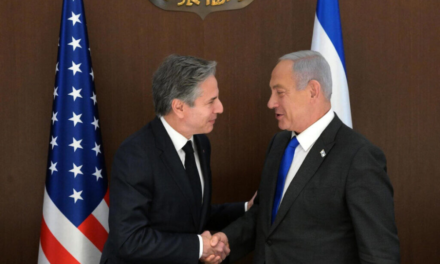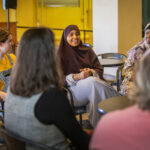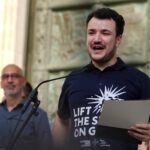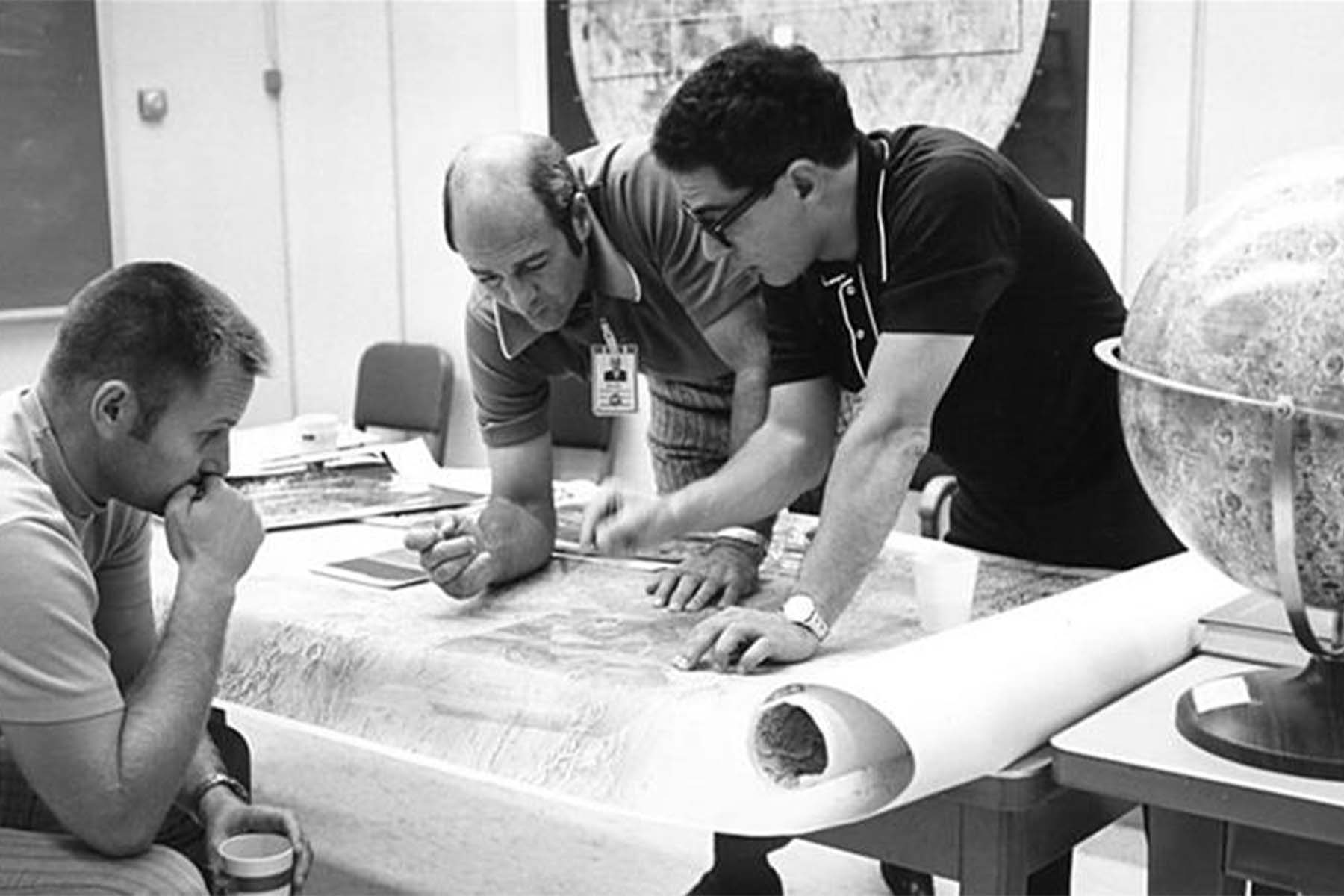
Alsadair Soussi as “Profile: Farouk El-Baz, the Egyptian behind the Moon landings” for Al Jazeera
Farouk El-Baz on the right with glasses, guiding astronauts Robert F Overmyer, seated, and Ronald Evans discuss as to potential lunar landing sites [NASA]
Half a century ago, as Apollo 11’s lunar module, known as the Eagle, made its way to the surface of the Moon, rows of scientists and space experts back in the United States state of Texas joined the rest of the world in holding their breath
Onboard the spaceflight were commander Neil Armstrong and lunar module pilot, Edwin Eugene “Buzz” Aldrin, Jr. Michael Collins, whose role was to ferry the two men from Earth and back again, manned the command module, Columbia, in orbit.
Among those at Mission Control in Houston was Gene Kranz, one of Apollo 11’s flight directors. But joining the rest of the ground crew was a brilliant 31-year-old Egyptian scientist. His name was Farouk El-Baz – and his participation with Apollo 11 would launch his scientific career to dizzying heights.
El-Baz was secretary of the Lunar Landing Site Selection Committee for the Apollo Programme of the US space agency, NASA. And, as he watched Armstrong and Aldrin pitch towards this weatherless lunar landscape, 50 years ago on July 20, 1969, the realisation that these two men would be the first-ever human beings to walk the Moon’s surface caused his heart to almost skip a beat.
“During the first human landing on the moon, I could only think of the mission success with the view of the two astronauts on my mind,” says El-Baz, speaking to Al Jazeera from his home in Leesburg, Virginia. “I was part of the team that certified the adequacy of the landing site. Any mishap would reflect badly on the whole project and might result in the cancelling of Apollo all together,” he adds.
“What a burden.”
It was, says El-Baz, the safety of the landing site itself that was of particular concern to him as the heavily cratered lunar surface prepared to receive this man-made space module.
He continues: “We all breathed a sigh of relief when the spacecraft landed – with only 60 seconds of fuel left in its engine.”
Standing in the beating heart of this pioneering project in the late 1960s US, El-Baz was very far from home. Born in January 1938 in the Nile Delta town of Zagazig, his first years of primary school were in Damietta, an Egyptian port city more than 200km north of the nation’s capital, Cairo. It was here that his love of science and the natural world was born.
“Every year I would watch with great fascination the Nile floods during July and August,” recalls the 81-year-old. “The Nile water turned brown from its heavy load of soil particles. It also carried an array of crocodiles and huge leaves of unfamiliar plants carried from farther south in equatorial Africa.”
His interactions with the “colourful rocks of the Yellow Mountain and the Red Mountain, as well as the caves in the nearby Mokattam Mountain” when he moved to Cairo with his family, inspired him to read science at the city’s Ain Shams University. He studied geology, chemistry, biology and mathematics, graduating with a bachelor of science in 1958.
He then headed to the US where he gained a Masters degree followed by a PhD in geology. Fresh from securing his doctorate in the US, he spent 18 months teaching at Heidelberg University in Germany.
A return to Egypt saw him try and fail to secure a university position. But what was Egypt’s loss, was the US’s gain. He returned to the US in 1967 and interviewed successfully for Bellcomm, which provided engineering support to NASA’s headquarters.
“I was part of the team that selected lunar sites for all six human landings on the moon,” says El-Baz, explaining his role from 1967 to 1972. He was not only secretary of the Landing Site Selection Committee for the Apollo missions during these years, but a principal investigator of Visual Observations and Photography and chairman of the Astronaut Training Group of the Apollo Photo Team.
He recalls the unique position he held at NASA in his early days as a non-US scientist, particularly as one from the Middle East. Then-Egyptian President Gamal Abdel Nasser may have suffered a catastrophic defeat to Israel in the 1967 War, but he was still lionised across the region and had forged ties with US’s Cold War-era enemy, the Soviet Union.
“First, I was a ‘foreigner’ because I could not apply for citizenship until after three years of residence in the US,” El-Baz explains. “Second, I was a mining geologist with no background in astronomy. Third, I was an Arab and an Egyptian at a time when the Soviets were all over Egypt … Thus, I had to prove myself essential to be treated with any respect, particularly in the beginning.”
In 1969, El-Baz was still a year away from becoming a naturalised US citizen. But, this ambitious young Egyptian national was now part of an historic moment of human endeavour. In fact, following Armstrong’s iconic “giant leap for mankind” spacewalk and safe return to Earth with Aldrin and Collins, El-Baz had written his own name into the history books.
Al Worden, a friend and colleague of El-Baz, was command module pilot for the Apollo 15 mission to the moon in 1971. He describes the Egyptian-American as “an exceptional, unique, wonderful guy”.
Worden, referring to El-Baz’s nickname of “the King” after King Farouk, Egypt’s penultimate monarch, was widely quoted as saying: “After ‘the King’s’ training, I feel like I’ve been here before.”
“I was very, very well equipped to do what had to be done on the plane thanks to Farouk,” Worden, author of Falling to Earth-An Apollo 15 Astronaut’s Journey to the Moon, confirms to Al Jazeera.
The Apollo 15 astronaut also issued greetings in several languages from space, including in Arabic, under El-Baz’s instruction. The now 87-year-old Worden, then speaking his colleague’s native tongue, managed to repeat the words, “Marhaba ahl el-ard min Endeavour elaykum salam” or “Hello people of the Earth – greetings from [spacecraft] Endeavour.”
After the Apollo programme ended, El-Baz joined the Apollo-Soyuz Test Project – a joint US-Soviet Earth-orbiting mission. Following this, he went back to his desert roots.
“I dedicated the rest of my career to assuring that we acquired as much space imagery of desert landforms, and to visit the dry lands of the Earth in all continents,” says the multi-award-winning scientist. He was also honoured in a Star Trek: The Next Generation episode when a shuttlecraft was named “El-Baz”.
Today, as an octogenarian, the father-of-four adult daughters remains fiercely active. Although retired from his position as director of Boston University’s Centre for Remote Sensing, a NASA-recognised Centre of Excellence, he travels regularly to the Middle East to encourage desert research.
Now, 50 years after his part in putting the first men on the Moon, and his subsequent years at the sharp end of the Apollo programme, the Arab-born scientist “feels accomplished”. Indeed, the six lunar landings saw 12 astronauts walk the moon’s terrain at the six landing sites that El-Baz and his colleagues selected.
“None of us knew for certain that all would work out as per our interpretation of satellite photographs,” he adds. “But, we certainly employed the best possible scientific methodologies and applied tried-and-proven ways to do the best possible job under the circumstances. I certainly feel good about all that was done in those days, including my part in that process.”

